ACE/OSIRIS Arctic Validation Campaign
Our Instruments
An essential component of the ACE/OSIRIS Arctic Validation Campaign are the
instruments which we are using to make our measurements. As you read
through our daily reports you might be wondering a little about what
we're talking about. Here are some of the participants in the campaign:
Fourier Transform Spectrometers
The Fourier Transform Spectrometers (FTSs) being used during the Arctic
Campaign are all direct-sun, infrared absorption instruments. Sunlight
enters the instrument by way of a tracker mounted on the roof and
several mirrors inside the FTS lab. Once inside the instrument, the
light is split into two beams by a beam-splitter. A changing path
difference between the two beams is introduced by the use of a moving
mirror in one beam. The constructive and destructive interference that
results when the beams are recombined is measured by a detector. This signal
is called an interferogram. A mathematical transformation, the Fourier transform,
of the interferogram produces a spectrum, which is essentially a 'fingerprint'
of the atmosphere that the sunlight has passed through on its way to the instrument.
Absorption features in the spectrum are produced by specific molecules in the
atmosphere, providing information about the concentration and location of these
gases.
At PEARL there are now two FTS instruments, each of slightly different design and
spectral resolution. They are capable of measuring more than 15 different gases,
including O3, NO2, NO, HNO3, N2O, CO,
CH4, HCl, HF, CO2, COF2 and ClONO2.
 CANDAC Bruker IFS 125HR
CANDAC Bruker IFS 125HR
The Bruker IFS125HR is a permanent resident of PEARL. It was installed in July
2006, and is part of the CANDAC suite of instruments. It has very high
resolution (0.0035 cm-1) and has two detectors - an InSb for the
1800-8500 cm-1 region and an MCT for the 500-5000 cm-1 region
- which are cooled with liquid nitrogen. The Bruker operates year-round
(when the Sun is up), giving us a long-term dataset to help us to better
understand the composition and changes occurring in the Arctic atmosphere. This instrument
is part of the international NDACC,
TCCON, and
MUSICA
networks.
PARIS-IR
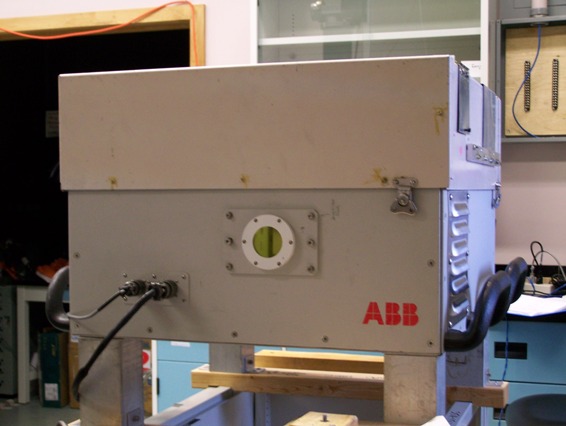 The Portable Atmospheric Research Interferometric Spectrometer for the
Infrared (PARIS-IR) is a terrestrial version of the ACE-FTS, the
high-resolution FTS on board SCISAT-1
(http://www.ace.uwaterloo.ca).
It is small and portable compared to the other FTS instruments,
and is only at Eureka during the ACE/OSIRIS validation campaign each spring.
The Portable Atmospheric Research Interferometric Spectrometer for the
Infrared (PARIS-IR) is a terrestrial version of the ACE-FTS, the
high-resolution FTS on board SCISAT-1
(http://www.ace.uwaterloo.ca).
It is small and portable compared to the other FTS instruments,
and is only at Eureka during the ACE/OSIRIS validation campaign each spring.
Like the other FTSs, PARIS-IR uses infrared radiation from the Sun to measure absorption spectra of the gases in the Earth's atmosphere. While PARIS-IR has a lower resolution (of 0.02 cm-1) than the other FTSs, each spectrum measured by PARIS-IR covers the full spectral range (750-4400 cm-1).
This allows changes in the concentrations of all of the trace gases to
be measured simultaneously throughout the day.
PARIS-IR in the PEARL FTS lab. Photo by A. Harrett
UV-Vis spectrometers
As their name implies, UV-Vis spectrometers are instruments which
directly collect spectra in the UV and visible regions of the electromagnetic
spectrum. UV-Vis spectrometers use a grating to split light into spectra
(much as a prism divides white light into a 'rainbow'), which
are recorded directly by the detector and electronics. For this campaign there is a
suite of UV-Vis instruments, each recording over a similar wavelength
region, but with differing resolution.
UT-GBS and PEARL-GBS
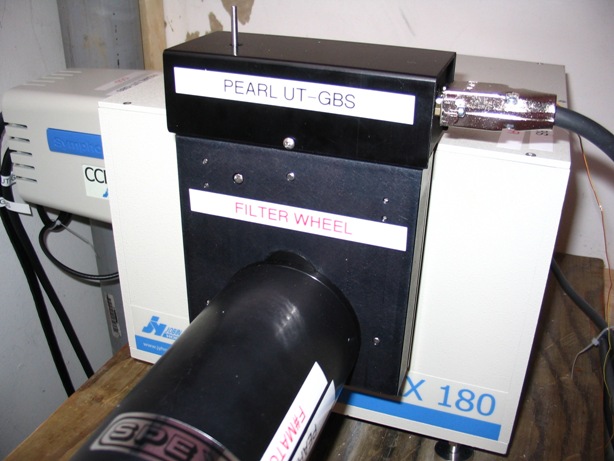 PEARL-GBS. Photo by A. Fraser
PEARL-GBS. Photo by A. Fraser
During the campaign, there will be two University of Toronto ground-based
instruments in operation at PEARL. These are zenith-sky (looking straight up)
UV-Visible spectrometers which measure stratospheric trace gases
from the ground using a well-established method of retrieval called Differential
Optical Absorption Spectroscopy (DOAS) to determine vertical columns of
ozone and NO2, and slant column densities of BrO and OClO.
One of these instruments, the UT-GBS, records zenith scattered sunlight spectra.
It has been deployed in the Arctic for polar sunrise every year since
1999. The other instrument, the PEARL-GBS, was installed permanently in Eureka
in August 2006 for year-round operation, and will record direct-sun spectra,
using a new sun-tracker developed at the University of Toronto.
With two instruments working together, one in zenith mode and one in direct-sun
mode, information on the vertical distribution and diurnal variation of BrO can
be retrieved using an optimal estimation method. The UT-GBS and PEARL-GBS are
NDACC instruments.
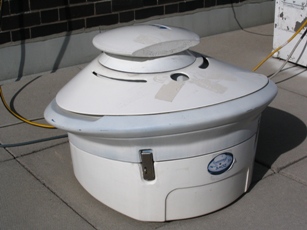 SAOZ
SAOZ
SAOZ
(Systeme d'Analyse par
Observation Zenithale) is an automated, zenith-sky-viewing UV-Visible
spectrometer on loan from Service d'Aeronomie, CNRS
(France), for the ACE Validation Campaign. SAOZ instruments are
widely used around the world, and are specifically designed for making
stratospheric column measurements in polar regions. SAOZ measurements are made in
the 300-600 nm wavelength range with a resolution of about 0.8 nm,
primarily at solar zenith angles greater than 81
degrees. The DOAS method is used for retrieving
stratospheric gas column amounts of O3 and NO2
in a similar way to the GBS systems. SAOZ is an
NDACC instrument.
SAOZ. Photo by A. Fraser
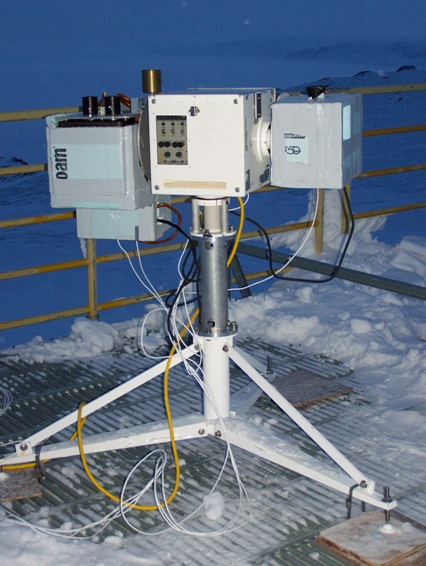
SPS
SPS (Sun Photo Spectrometer) is a light-weight, compact, photodiode array
spectrophotometer. It has a holographic diffraction grating which
focuses the spectra, in the range of 290-775 nm in two orders, onto a
detector. It has a spectral resolution of approximately 1.2 nm in the second
order and 2.5 nm in the first order. A
double filter-wheel assembly inside the instrument allows a selection of
filter combinations for different purposes, including order selection
and polarizing filters. The SPS has flown on the Space Shuttle and
several ER-2 aircraft campaigns, and is a
temporary visitor at Eureka for the spring campaigns. Here its primary
focus is measurements of atmospheric NO2 and O3
concentrations. It can also measure sky brightness and aerosols.
MAESTRO (left) and SPS (right) on the roof of PEARL. Photo by T. Kerzenmacher
MAESTRO-G
MAESTRO-G (Measurement of Aerosol Extinction in the Stratosphere and Troposphere
Retrieved by Occultation) is the ground-based equivalent of
ACE-MAESTRO, which is currently flying on the ACE satellite.
It is composed of two independent diode-array spectrometers measuring
in the UV-Visible (285-565 nm) and the visible-near-infrared (515 -1015
nm) spectral regions, each with a resolution of approximately 2 nm.
Each spectrometer consists of a lens, slit, concave holographic grating
and a photodiode array detector. It can measure various atmospheric constituents,
including O3, NO2, BrO, NO3, and aerosols.
MAESTRO-G is mounted on one side of a solar
tracker (the left, in the picture), and the SPS is mounted on the other.
Measurements are made in zenith sky mode (pointing straight up) most of
the time, but for a short period during each degree of zenith angle
the instruments make measurements while pointed directly at the sun. This is
important for the process used to retrieve gas amounts from the
recorded spectra.
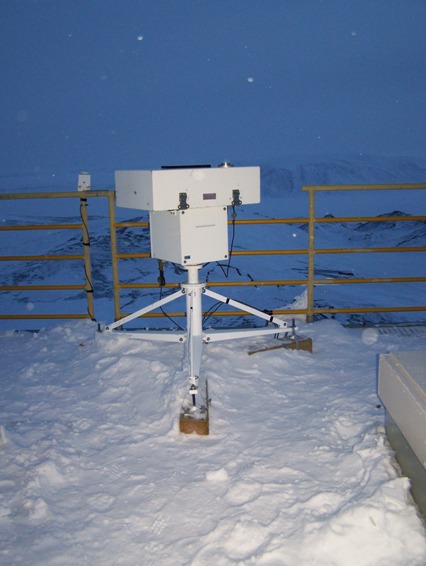 The Brewer Spectrophotometer
The Brewer Spectrophotometer
The Brewer spectrophotometer is an internationally recognized WMO standard
instrument for the measurement of ozone. In simple terms, it uses the
fact that ozone has a large difference in its absorption strength at
different wavelengths to determine the amount of ozone in the
atmosphere between the instrument and the sun. Unlike the older, manual
Dobson instrument, which uses prisms to break the light into spectra, the Brewer uses a
holographic grating and is completely automated.
There are three Brewer spectrophotometers in operation at Eureka - one
at PEARL and two at the weather station. The three instruments are all
different models with slightly different gratings and operating in
different orders (which gives them different wavelength regions to look
in). As well as ozone data, NO2 can be determined. The data from these instruments goes into the world-wide network to monitor ozone change.
Brewer Spectrophotomer, Photo T. Kerzenmacher

Ozone Profiling Instruments
DIAL
A LIDAR (LIght Detection and Ranging) is an instrument that uses
laser light to detect particles and gases in the atmosphere. Light
pulses are sent into the atmosphere where they
are scattered back by aerosol particles and air molecules and absorbed
by atmospheric constituents. The returned light is captured in
a telescope, and is used to study the location and nature of particles
and molecules in the atmosphere. Environment Canada has had a DIfferential
Absorption LIDAR (DIAL) at Eureka since 1993. Over the past two years, the PEARL DIAL
has been rebuilt by CANDAC. The DIAL is a special type of lidar
that uses more than one wavelength to detect differences in absorption.
For example, by studying the difference in absorption at wavelengths
where ozone absorbs strongly and weakly, a very accurate profile of the ozone
distribution can be obtained. Because the returned light is very weak
(it is being scattered back from very high altitudes by molecules and
particles), the DIAL operates only at night when the background light is
less intense. In addition to measuring ozone, DIAL measurements can also
produce temperature profiles.
DIAL LIDAR over PEARL, Courtesy T. Nagai
Balloon filling for an ozonesonde launch. Photo by T. Kerzenmacher
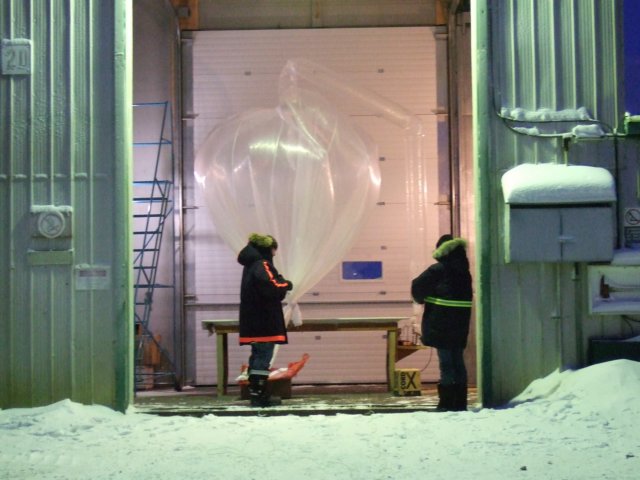
Ozonesondes
Unlike the other campaign instruments, which measure remotely (either
from the ground or a satellite), an ozonesonde actually travels through the atmosphere
measuring the local concentration of ozone. To do this, the instrument
catches a ride on a hydrogen-filled balloon which rises up through
the atmosphere (just like those helium filled ones you had as a kid - but a lot bigger!) The
instrument itself is a small chemical cell. Air is sucked into one
chamber of the cell. Ozone in the air sample reacts with the chemical,
causing a current to flow. The concentration of ozone is determined
from the measured current. The ozone amount, along with temperature, pressure and humidity
information that are also measured along the way, is transmitted back
to earth as the balloon goes up, using a radio signal. The
ozonesonde gives us a very high-precision profile of the ozone through the part of
the atmosphere that it measures. As you can imagine, this is very
useful for helping verify the data that we get with the other
instruments. Unfortunately, because ozonesondes are expensive (those
balloons get to as big as a hockey arena by the time they pop at
around 30km!), measurements are not made as frequently
as with the other instruments. Thus, an important part of
this campaign is the daily launch of ozonesondes during the
campaign's intensive phase.

 CANDAC Bruker IFS 125HR
CANDAC Bruker IFS 125HR PEARL-GBS. Photo by A. Fraser
PEARL-GBS. Photo by A. Fraser SAOZ
SAOZ
 The Brewer Spectrophotometer
The Brewer Spectrophotometer
